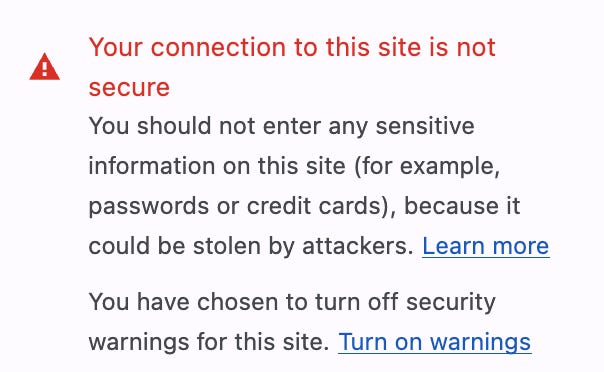In the digital world, your website serves as the front door to your organization. It's where potential donors, supporters, and the curious public get an impression of who you are and what you stand for. But what if they're greeted with a warning that your website is "not secure"? This could be more than just a technical hiccup—it can erode trust and credibility.
In this blog, we'll walk through the steps to secure your website, explain the importance of website security, and discuss how your website's security perception impacts your credibility, especially if you're involved in advocacy, politics, or running a private organization.
Why Website Security Is A Must-Have
Building Trust
When visitors see a "Not Secure" warning, it's akin to walking up to a shop with broken windows. It doesn't matter if you are running the most cutting-edge campaign or championing a heartfelt cause—security matters. That padlock icon that appears next to your URL isn’t just an ornament; it symbolizes safety and authenticity.
Data Protection
Security isn't just about perception; it's a vital part of data protection. Personal data, sensitive campaign information, and financial transactions require encryption to keep them safe from prying eyes.
SEO Ranking
Furthermore, search engines like Google favor secure sites. A "Not Secure" label may lower your rankings, meaning your site becomes harder to find, and less traffic is directed to your cause.
Steps To Secure Your Website
Step 1: Understand the Warning
The "Not Secure" warning appears when a website is not protected by an SSL certificate. It means the data between the user's browser and your website is not encrypted.
Step 2: Obtain an SSL Certificate
An SSL (Secure Sockets Layer) certificate is what you need to solve this issue. It encrypts data sent over the internet between a browser and a server, making it nearly impossible for hackers to intercept.
Step 3: Install Your SSL Certificate
The process varies depending on your hosting service, but generally, it involves purchasing the certificate and following your provider’s setup protocol to install and activate it.
Step 4: Ensure SSL Is Fully Implemented
Even with an SSL certificate, content on your site might still be loaded over an insecure connection (look for mixed content errors). Check your site and update any internal links, images, or scripts to use HTTPS. There are plugins and online tools to help with this if your site is large.
Step 5: Renew and Maintain
SSL certificates expire, so set reminders for renewal. Keeping your SSL certificate up to date is important for maintaining a secure site.
The Impact of Not Securing Your Website
Ignoring the "Not Secure" warning impacts your credibility. Supporters need to trust you with their data (like email addresses and donation details), and a secure website plays a crucial role in that trust. In advocacy and political campaigns, where confidentiality and integrity are pivotal, security cannot be an afterthought. It has to be part of your brand promise.
Consider website security as part of your reputation management. Just like you wouldn't skimp on the quality of your campaign literature, don't cut corners on securing your website. It's a small investment that pays dividends in trust and engagement.
Conclusion
A secure website is non-negotiable in today’s cyber landscape. SSL certificates provide a basis for trust and safety on the internet. They protect your visitors, enhance your SEO, and solidify your credibility. Remember, when you show care for your supporters’ security, you're showing care for your mission.
Take action now to secure your website. It's a straightforward process that can have significant positive implications for the success of your advocacy or political campaigns.
Is your website still sporting the dreaded "Not Secure" label? It’s not too late to turn things around. Secure your website today and ensure your credibility remains intact tomorrow.
Your advocacy deserves no less than a secure platform. If you need help securing your website, reach out today! APL@andrewloposser.com



